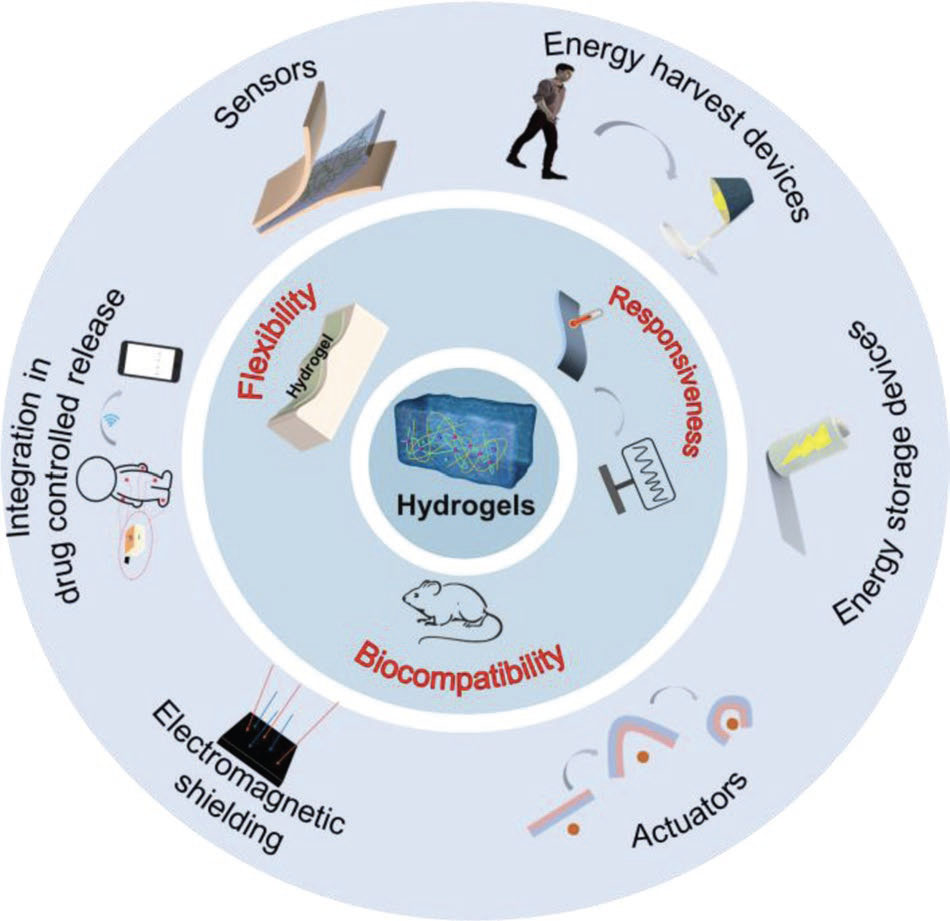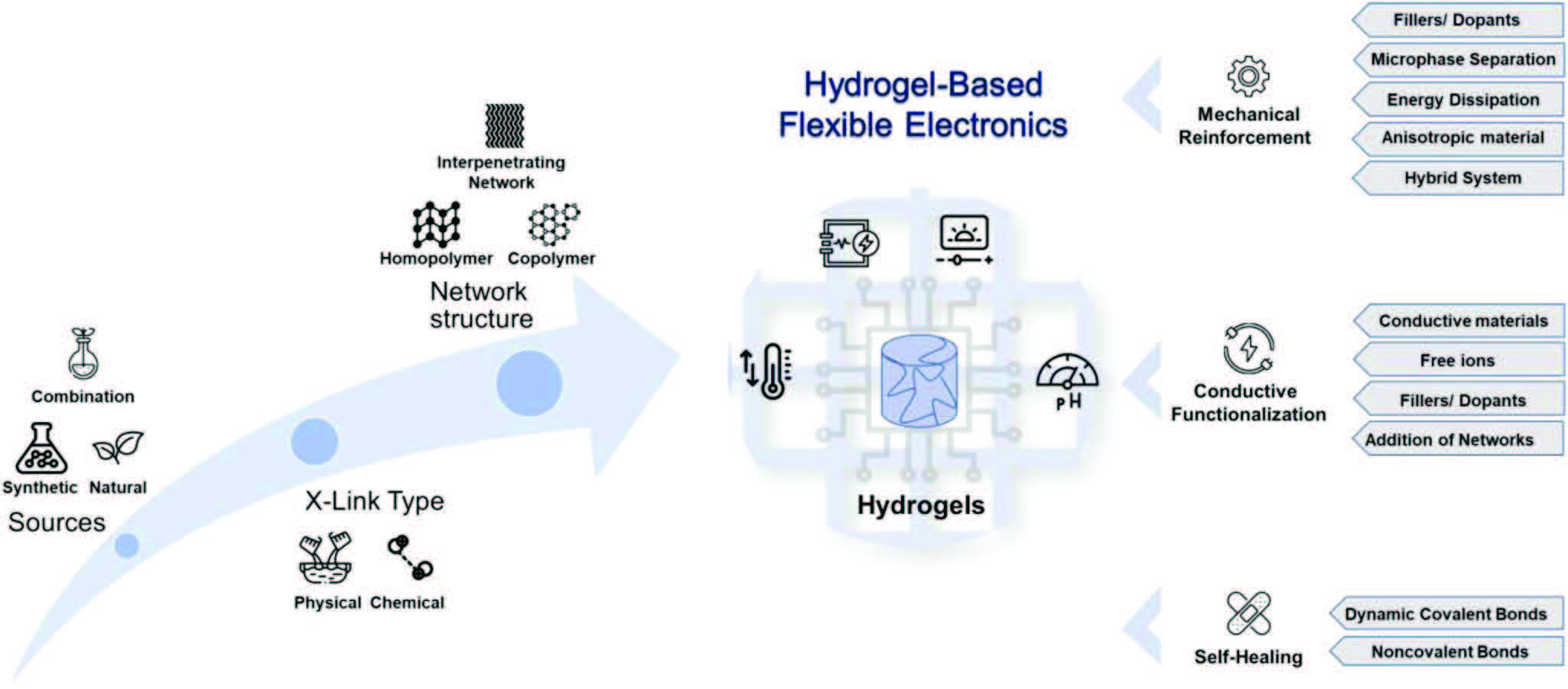| Apr 11, 2023 | |
Hydrogel-based flexible electronics |
|
| (Nanowerk Spotlight) Flexible electronics, which can maintain their functionality under various conditions such as bending, rolling, folding, or stretching, have seen significant advances in recent years. These electronics have expanded into a wide range of applications, including flexible sensors for monitoring physical and chemical changes, energy harvesting devices for converting mechanical or thermal energy into electrical energy, flexible energy storage devices like batteries and supercapacitors, flexible transistors, and flexible display screens used in smartphones and wearable devices. | |
| Hydrogels have emerged as a promising candidate for developing bioelectronics, which interface living biological tissues with synthetic electronic systems. These hydrogels closely mimic the mechanical, chemical, and optical properties of biological tissues, making them ideal for use in flexible electronic devices. | |
| Hydrogels are soft, bendable, stretchable, and possess self-healing properties due to their versatility in mechanical and bio-functional engineering. As a result, hydrogel-based flexible electronics can better conform and interact with biological tissues and organisms than traditional electronic components, which are often rigid, dry, or incompatible with human tissues. | |
| In this context, the latest methods for synthesizing functional hydrogels and their applications in various fields have been reviewed in Advanced Materials ("Hydrogel-Based Flexible Electronics"), highlighting the relationship between hydrogel properties and device performance. This understanding can pave the way for further development of flexible electronics using environmentally responsive hydrogels. | |
| Additionally, the review provides insights into current challenges and future directions for developing multifunctional hydrogel-based flexible electronics, which can enhance the performance and scope of applications in this emerging field. | |
 |
|
| Main features of hydrogels and their applications in flexible electronics. (Reprinted with permission by Wiley-VCH Verlag) | |
| The review provides a detailed overview of hydrogels, approaches to boost hydrogen functionality, and applications of hydrogel-based flexible electronics such as sensors, energy harvesting and storage devices, actuators, transistors, electromagnetic shielding, touch creens, and devices for controlled drug release. | |
| Recent research in hydrogel-based flexible electronics has primarily focused on overcoming their inherent limitations. One major limitation is their poor conductivity, which makes it challenging to directly print circuits on hydrogels. To address this issue, researchers have explored various approaches, such as incorporating conductive fillers or dopants, selecting hydrogels made of conductive polymers, and introducing a double-network strategy that combines both conductive and non-conductive elements within the hydrogel structure. | |
| Another challenge is the mechanical weakness of hydrogels, which can limit their durability and performance in flexible electronics. To improve their mechanical properties, researchers have experimented with adding fillers or dopants to enhance the hydrogel's strength, adopting energy dissipation platforms to distribute stress more effectively, using anisotropic materials that exhibit different properties in different directions, and employing hybrid systems that combine multiple materials to achieve better overall performance. | |
| Self-healing capability is a crucial parameter for electronic skins, which can mimic the sense of touch and monitor vital signs. Various methods have been investigated for realizing self-healing in hydrogels, which can be categorized under two major approaches: those based on dynamic covalent bonds that can reversibly form and break, and those based on noncovalent bonds, such as hydrogen bonding or ionic interactions. | |
 |
|
| Overview of hydrogels and approaches to boost their functions for hydrogel-based flexible electronics. (Reprinted with permission by Wiley-VCH Verlag) | |
| Despite significant progress in developing hydrogel-based flexible electronics, several challenges remain. These include integrating multiple functions into a single device, making them easily customizable and adaptable to different needs and circumstances, and improving their wearability or implantability for seamless integration with biological systems. Additionally, the long-term stability, temperature-related performance, and self-repairing ability of hydrogels need to be improved to meet the functional requirements of data collection and communication. | |
| To address these challenges, researchers are leveraging the convergence of various technological innovations, such as new materials discovery, novel properties and functions of conventional materials, advances in materials processing like additive manufacturing, and improvements in wireless communications like advanced Bluetooth or NFC technologies. These innovations and synergies are accelerating the development of powerful flexible electronics, bringing them closer to becoming an integral part of our daily lives. | |
 By
Michael
Berger
– Michael is author of three books by the Royal Society of Chemistry:
Nano-Society: Pushing the Boundaries of Technology,
Nanotechnology: The Future is Tiny, and
Nanoengineering: The Skills and Tools Making Technology Invisible
Copyright ©
Nanowerk LLC
By
Michael
Berger
– Michael is author of three books by the Royal Society of Chemistry:
Nano-Society: Pushing the Boundaries of Technology,
Nanotechnology: The Future is Tiny, and
Nanoengineering: The Skills and Tools Making Technology Invisible
Copyright ©
Nanowerk LLC
|
|
|
Become a Spotlight guest author! Join our large and growing group of guest contributors. Have you just published a scientific paper or have other exciting developments to share with the nanotechnology community? Here is how to publish on nanowerk.com. |
|
